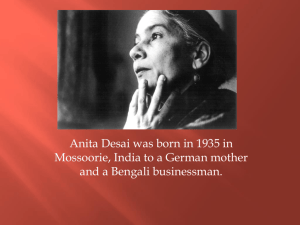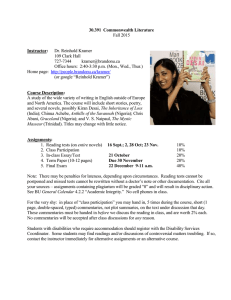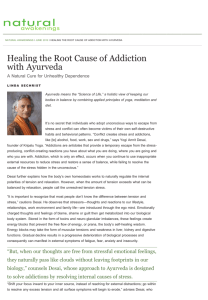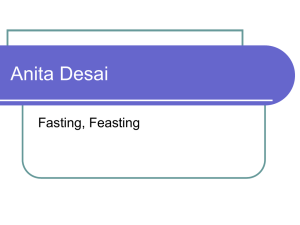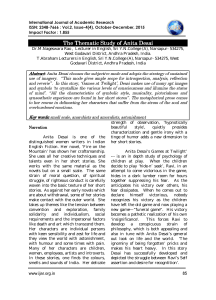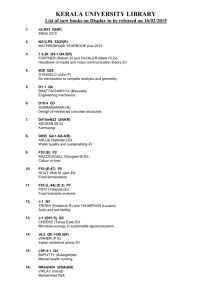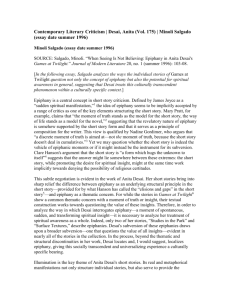Rural sociology in India - Economic and Political Weekly
advertisement
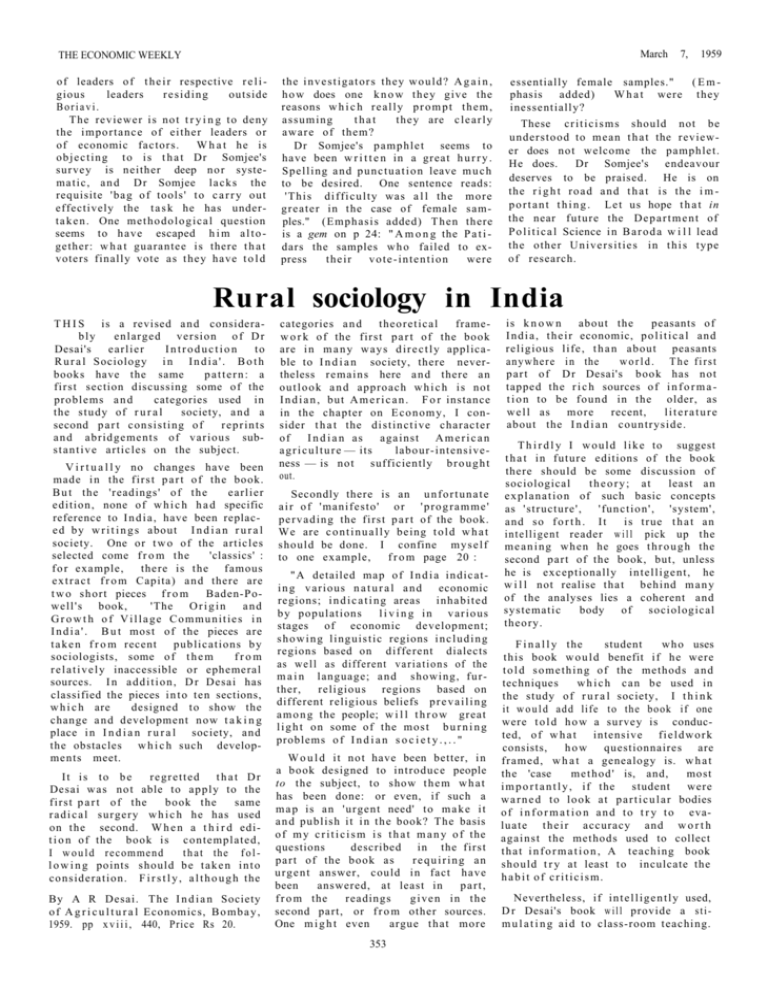
March THE ECONOMIC WEEKLY of leaders of t h e i r respective r e l i gious leaders residing outside Boriavi. The reviewer is n o t t r y i n g to deny the i m p o r t a n c e of either leaders or of economic factors. W h a t he is o b j e c t i n g to is t h a t Dr Somjee's survey is neither deep nor systematic, a n d D r Somjee l a c k s the requisite 'bag o f tools' t o c a r r y out effectively the t a s k he has undert a k e n . One m e t h o d o l o g i c a l question seems to have escaped h i m a l t o gether: w h a t guarantee is there t h a t voters finally vote as t h e y have t o l d the i n v e s t i g a t o r s they w o u l d ? A g a i n , h o w does one k n o w t h e y give the reasons w h i c h r e a l l y p r o m p t t h e m , assuming that they are c l e a r l y a w a r e o f them? Dr Somjee's p a m p h l e t seems to have been w r i t t e n in a great h u r r y . Spelling a n d p u n c t u a t i o n leave m u c h to be desired. One sentence reads: ' T h i s d i f f i c u l t y was a l l the more greater in the case of female samples." (Emphasis added) T h e n there is a gem on p 24: " A m o n g the P a t i dars the samples w h o failed to express their vote-intention were 7, 1959 essentially female samples." (Emphasis added) W h a t were they inessentially? These c r i t i c i s m s should not be understood to mean t h a t the reviewer does not welcome the pamphlet. He does. Dr Somjee's endeavour deserves to be praised. He is on the r i g h t r o a d a n d t h a t i s the i m p o r t a n t t h i n g . L e t us hope t h a t in the near future the D e p a r t m e n t of P o l i t i c a l Science i n B a r o d a w i l l lead the other U n i v e r s i t i e s i n t h i s type of research. Rural sociology in India T H I S is a revised a n d considerably enlarged version o f D r Desai's earlier Introduction to R u r a l Sociology i n I n d i a ' . B o t h books have the same pattern: a first section discussing some of the problems a n d categories used in the study of r u r a l society, a n d a second p a r t consisting of reprints a n d abridgements of various subs t a n t i v e articles on the subject. V i r t u a l l y no changes have been made i n the f i r s t p a r t o f the book. B u t the 'readings' o f the earlier edition, none of w h i c h h a d specific reference to I n d i a , have been replace d b y w r i t i n g s about I n d i a n r u r a l society. One or t w o of the articles selected come f r o m the 'classics' : f o r example, there is the famous e x t r a c t f r o m Capita) a n d there are t w o short pieces f r o m Baden-Powell's book, 'The O r i g i n a n d G r o w t h of Village Communities in I n d i a ' . B u t most of the pieces are t a k e n f r o m recent publications b y sociologists, some o f t h e m from r e l a t i v e l y inaccessible or ephemeral sources. I n a d d i t i o n , D r Desai has classified the pieces i n t o ten sections, w h i c h are designed to show the change a n d development n o w t a k i n g place i n I n d i a n r u r a l society, and the obstacles w h i c h such developments meet. It is to be regretted that Dr Desai w a s not able to apply to the first p a r t of the book the same r a d i c a l surgery w h i c h he has used on the second. W h e n a t h i r d edit i o n of the book is contemplated, I w o u l d recommend t h a t the f o l l o w i n g points should be t a k e n i n t o consideration. F i r s t l y , a l t h o u g h the By A R Desai. The I n d i a n Society o f A g r i c u l t u r a l Economics, B o m b a y , 1959. pp x v i i i , 440, Price Rs 20. categories a n d theoretical framew o r k of the first p a r t of the book are i n m a n y w a y s d i r e c t l y applicable to I n d i a n society, there nevertheless remains here a n d there an o u t l o o k a n d approach w h i c h i s not I n d i a n , but A m e r i c a n . F o r instance in the chapter on E c o n o m y , I consider t h a t the d i s t i n c t i v e character of I n d i a n a s against A m e r i c a n a g r i c u l t u r e — its labour-intensiveness — is not sufficiently b r o u g h t out. Secondly there is an u n f o r t u n a t e a i r o f 'manifesto' o r ' p r o g r a m m e ' p e r v a d i n g the first p a r t of the book. W e are c o n t i n u a l l y being t o l d w h a t should be done. I confine m y s e l f to one example, f r o m page 20 : " A detailed map o f I n d i a indicati n g various n a t u r a l a n d economic regions; i n d i c a t i n g areas inhabited b y populations l i v i n g i n v a r i o u s stages of economic development; s h o w i n g l i n g u i s t i c regions i n c l u d i n g regions based on different dialects as w e l l as different v a r i a t i o n s of the m a i n language; a n d showing, f u r ther, religious regions based on different religious beliefs p r e v a i l i n g a m o n g the people; w i l l t h r o w great l i g h t on some of the m o s t b u r n i n g problems o f I n d i a n s o c i e t y . , . . " W o u l d it n o t have been better, in a book designed to introduce people to the subject, to show t h e m w h a t has been done: or even, if such a m a p is an 'urgent need' to m a k e it a n d publish i t i n the book? The basis o f m y c r i t i c i s m i s t h a t m a n y o f the questions described in the first p a r t of the book as r e q u i r i n g an u r g e n t answer, could in fact have been answered, at least in part, f r o m the readings g i v e n i n the second part, or f r o m other sources. One m i g h t even argue t h a t more 353 is k n o w n about the peasants of I n d i a , t h e i r economic, p o l i t i c a l a n d religious life, t h a n about peasants anywhere i n the world. The first p a r t o f D r Desai's book has not tapped the r i c h sources of i n f o r m a t i o n to be found in the older, as w e l l as more recent, literature about the I n d i a n countryside. T h i r d l y I w o u l d l i k e to suggest t h a t i n future editions o f the book there should be some discussion of sociological t h e o r y ; at least an e x p l a n a t i o n of such basic concepts as 'structure', ' f u n c t i o n ' , 'system', and so f o r t h . It is true t h a t an intelligent reader w i l l pick up the m e a n i n g when he goes t h r o u g h the second part of the book, but, unless he is exceptionally intelligent, he w i l l not realise that behind m a n y of the analyses lies a coherent and systematic body of sociological theory. F i n a l l y the student w h o uses this book w o u l d benefit if he were t o l d s o m e t h i n g o f the methods a n d techniques w h i c h can be used in the study of r u r a l society, I t h i n k it w o u l d add life to the book if one were t o l d h o w a survey is conducted, o f w h a t intensive f i e l d w o r k consists, h o w questionnaires are framed, w h a t a genealogy is. w h a t the 'case m e t h o d ' is, and, most i m p o r t a n t l y , i f the student were w a r n e d to look at p a r t i c u l a r bodies o f i n f o r m a t i o n a n d t o t r y t o evaluate t h e i r accuracy and w o r t h against the methods used to collect t h a t i n f o r m a t i o n , A teaching book should t r y at least to inculcate the habit of criticism. Nevertheless, if i n t e l l i g e n t l y used, D r Desai's book w i l l provide a stim u l a t i n g a i d to class-room teaching. THE ECONOMIC WEEKLY 254 March 7, 1959 355
